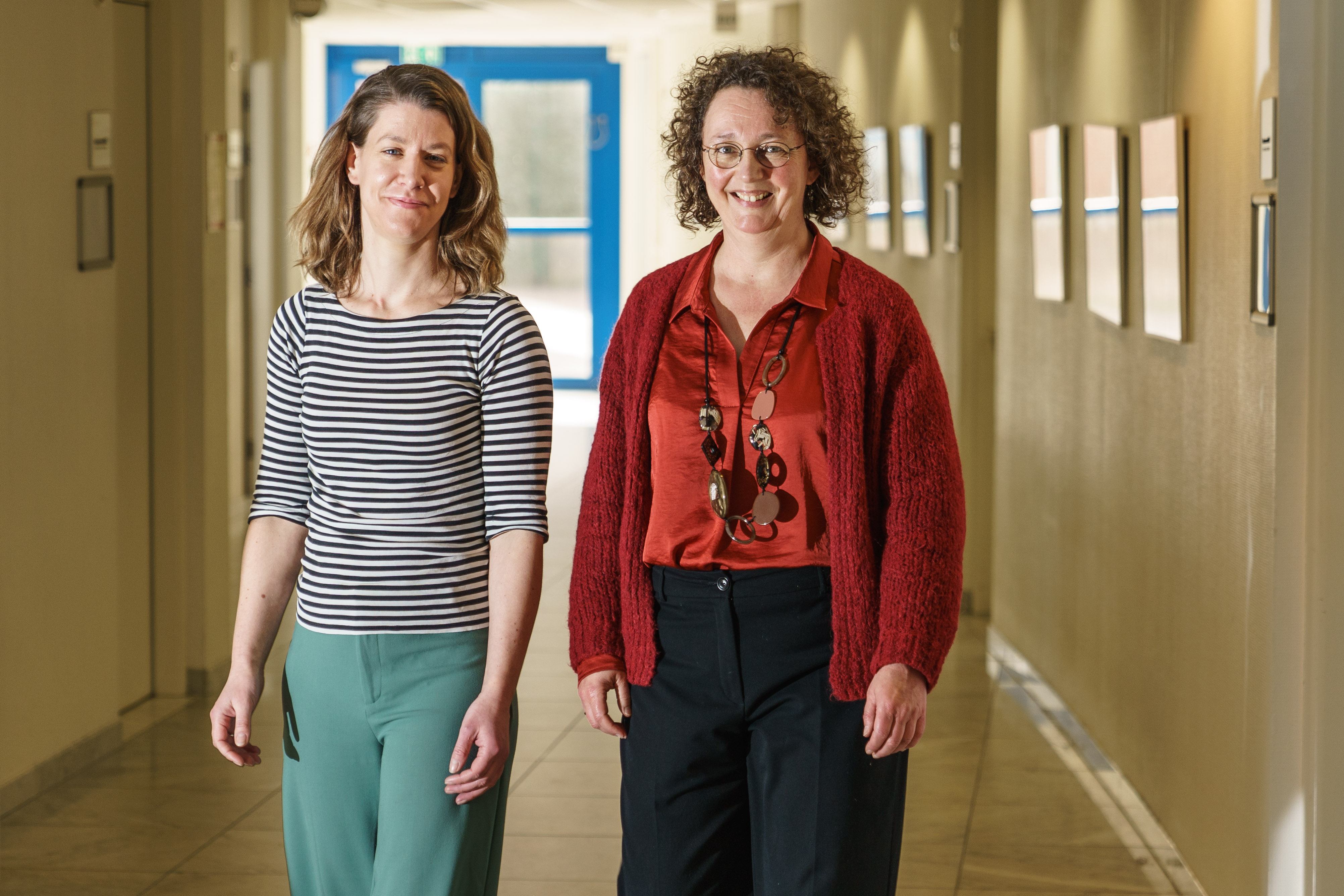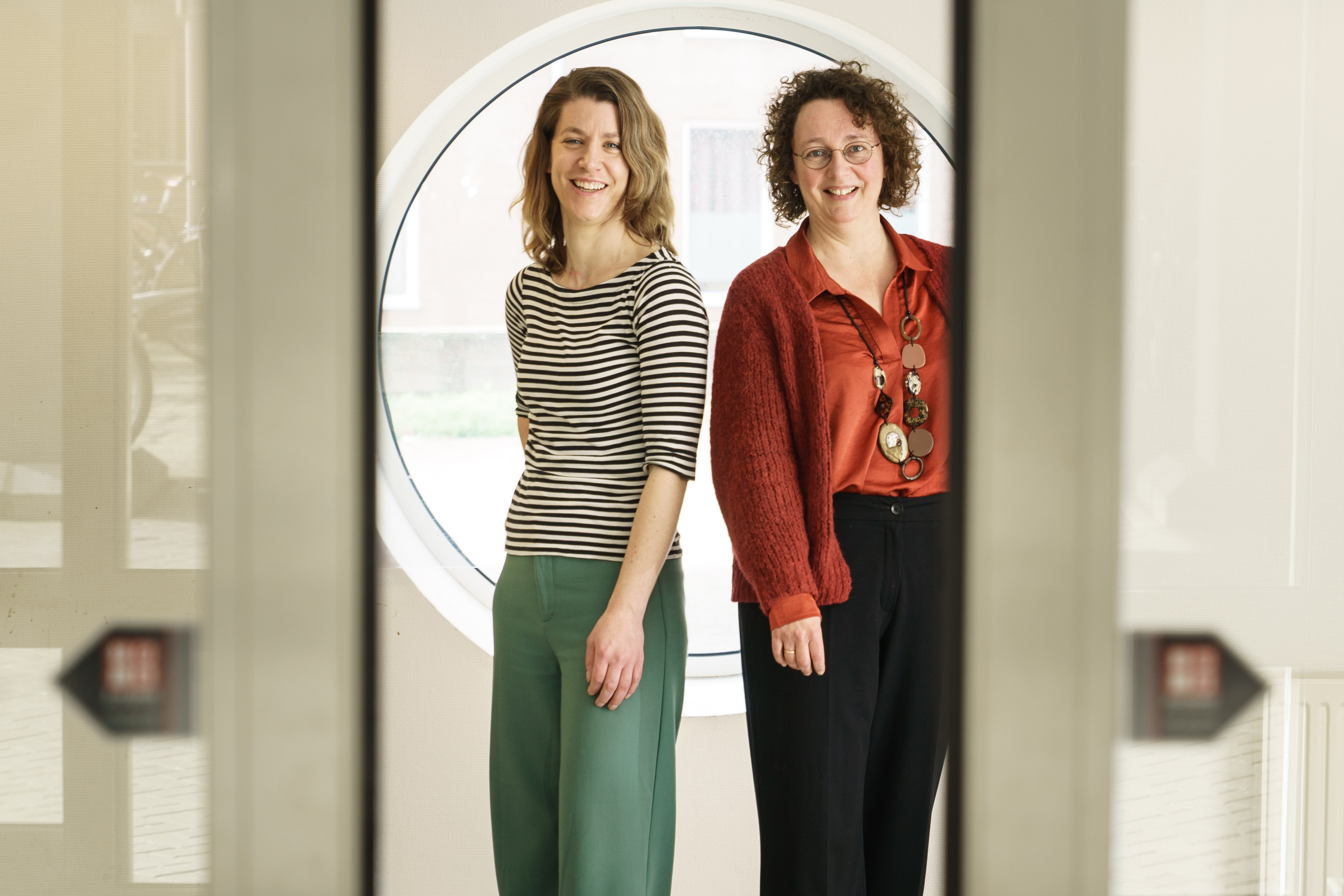The woman’s body in a man’s world
Professor of Health and Humanities prof Rina Knoeff and assistant professor of Cultural Heritage, Identity, and Early Modern History Dr Karen Hollewand make a case for gender health equality between men and women in medical sciences. "I believe we need to add some nuance to the huge tirades against the patriarchal society."
Text: Lieke van den Krommenacker | Photos: Reyer Boxem
At the end of January of this year Rina Knoeff and Karen Hollewand gave a public lecture in Groningen with a contradictory message: the historical call for gender equality has often led to a disregard for the female body. "That’s what we call the equality paradox", says Knoeff. "The more we believe we are equal, the less attention is paid to physical differences. The fact that the female body is still so undervalued in medical sciences is partly due to feminism and the women’s movements themselves."
For instance, Aletta Jacobs, in her 1898 book De vrouw, haar bouw en haar inwendige organen (The woman, her build, and her internal organs) states that there are no essential differences between men’s and women’s bodies. The differences we see are differences in form, but not in function. Knoeff: "In other words, women have exactly the same body, it just looks different. This idea has proven very influential, but ignores issues such as the menopause, which are absolutely woman-specific. In this regard, a female body differs from that of a male not only in its reproductive organs, but down to the cellular level."

Add nuance to tirades
So, can feminists suspend their battle? Certainly not, say the two colleagues, both of whom study the history of medicine and gender differences in medical sciences. It is a man’s world, and there’s no doubt about it, "but I do believe we need to add some nuance to the huge tirades against the patriarchal society", says Knoeff. Hollewand: "If it was all men’s fault, the problem should have been solved by now, because the world of medicine has long since ceased to be just a man’s world."
In their research, Knoeff and Hollewand constantly run into the gender health gap: the health inequality between men and women— as well as other genders— which, for one thing, causes a frightening lack of data. As a result, women sometimes not only have to wait years longer for a diagnosis, but their conditions are also more often overlooked or taken less seriously.
Some specific examples: in women with endometriosis, a condition that affects one in ten women, it takes an average of seven to ten years for a doctor to officially diagnose it. Bechterew’s disease, a form of inflammatory rheumatism, is detected on average five years later in women than in men. And those who visit their GP because of excessive menstrual cramps or premenstrual syndrome (PMS) soon return home with the message that ‘it’s all part of being a woman’ and that a paracetamol and a little less stress will surely help.
Haemorrhoids in vogue
The origin of this ‘systemic error’, as Hollewand characterizes it, lies partly in the discipline of medicine itself, in the rise of modern medicine in the nineteenth century. At the time, the first research laboratories and research hospitals emerged and doctors began to specialize. "But things also went awry: doctors were inclined to make too great a binary distinction between men and women, largely reducing the latter to their wombs."
Interestingly, if you look back even further, to premodern times, you will see that the distinction between men and women was much less absolute. Conditions that we now call specifically male or female could occur in both sexes. For instance, some men even suffered from monthly bleeding. How did that work? "For example, because of haemorrhoids and nosebleeds", says Knoeff. "Haemorrhoids were actually considered a fashionable thing for a while. Louis XIV was much affected by them, so haemorrhoids were openly discussed at court. In one of his medical publications, Dutch physician and chemist Herman Boerhaave also referred to a ‘gentleman’ who bled from his little finger every month..." Knoeff: "This apparently functioned in the same way as a menstrual period, where the body gets rid of waste products in a natural way."
Hollewand adds: "And whether or not it was called a menstrual period is of course not the issue here. The point is that, in premodern times, something like a monthly bleeding was not seen as something that could only affect women, but as a medical process that could occur in both men and women. This changed in the nineteenth century, when doctors started defining boundaries and gynaecology became a separate discipline."

Suffocation of the womb
Moreover, which people and which complaints we pay attention to and how we experience complaints is not only culturally determined but also historically. Take, for instance, menopause, a subject on which Knoeff is currently writing a book. "In the sixteenth century, 'suffocation of the womb', as it was then called, was the number one problematic symptom", she says. "This had everything to do with the toxic fumes from accumulated menstrual blood, which made women faint and caused them to have difficulty breathing. They sometimes even died. There is a story about the famous anatomist Andreas Vesalius who cut into a woman’s lifeless body, while she turned out to be still alive. This ended in a huge scandal, eventually forcing Vesalius to flee. We laugh about it now, but it is very telling of the times. And although breathlessness is still a menopausal symptom, these days we mostly talk about hot flushes and it’s all about hormones."
Something similar applies to PMS, Hollewand points out. "The symptoms have been more or less the same for thousands of years. What changes is the point of emphasis, which depends on the sources and research methods that experts rely on. This way, the female body is defined differently each time, but things like PMS, menstruation, and menopause still remain mainly a women’s problem."
The laws of the old-fashioned system
What Hollewand and Knoeff cannot repeat often enough is that anyone looking at ‘the long line’ of history will see that modern medicine floats on mechanisms that have been repeating themselves over and over again since the nineteenth century. Hollewand: "Men and women rely on all kinds of cultural assumptions about how women function and experience things. Only when you become aware of this you can understand why things are changing so slowly. You might say: there are many more female doctors and medical students nowadays, right? But they, too, are operating in the same ‘old-fashioned’ system and conforming to its laws, and they determine just as much how research money should be spent."
Knoeff recalls a doctor in Canada who discovered that Viagra was thought to help with menstrual pain and PMS symptoms. "That would be great. So that man applied for all kinds of funding to investigate this further. Only, he never got the funding because Viagra is associated with men and erectile dysfunction." Another common argument is that research on ‘women’s ailments’ costs too much money, so let’s by all means put the money into problems that apply to everyone. "And there you run into the system again", says Hollewand. "While persistent health inequalities cost society annually between €2.5 and €7.8 billion."
Still, with more money and more data, the problem will not be automatically solved. Hollewand: "In fact, you can already see that the money promised by politicians is being allocated by medics in advance. But you also have to look at cultural and historically rooted assumptions about men’s and women’s bodies. Only then will you be able to make structural changes."
| Last modified: | 02 May 2024 2.43 p.m. |
More news
-
06 May 2024
Impact: Utilization of geospatial data within international development cooperation
One of students nominated for the Ben Feringa Impact Award 2024 is Jonas Göbel. Göbel is nominated because of his internship research around the utilization of geospatial data in the field of international development cooperation.
-
03 May 2024
NWO Impact Explorer for Suzanne Manizza-Roszak's impactful postcolonial literary research
Suzanne Manizza-Roszak, Assistent Professor English at the Faculty of Arts has received an Impact Explorer grant from the Dutch Research Council (NWO) for her postcolonial literary research and the project to translate the results into social...
-
29 April 2024
Learning to communicate in the operating theatre
The aios operates, the surgeon has the role of supervisor. Three cameras record what happens, aiming to unravel the mechanisms of 'workplace learning'.
